This amazing gluten-free Irish soda bread recipe is made with gluten-free flour, cold butter, buttermilk, and just enough sugar to sweeten the loaf. Thanks to the baking soda, there’s no rise time needed. So it’s a quick and easy bread to make. Perfect for St. Patrick’s Day.
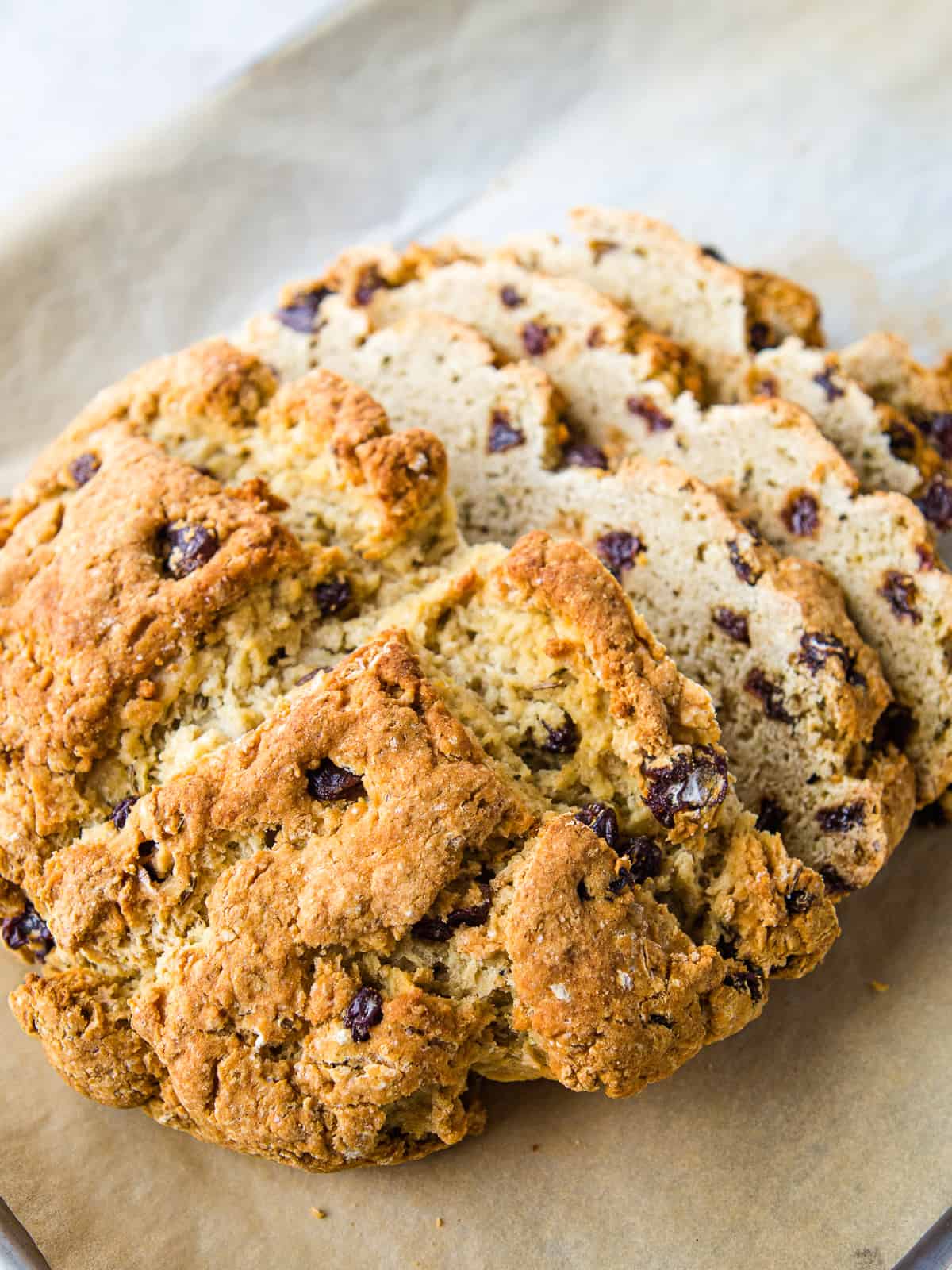
If you’ve never had Irish soda bread, you’re in for a treat. Although it has “bread” right in the name, it’s nothing like gluten-free sandwich bread or gluten-free pumpkin bread. Irish soda bread is more like a giant scone or biscuit. And that’s what makes it so irresistible.
This recipe is inspired by the sweet, raisin, and caraway-filled loaves found in the United States around St. Patrick’s day. It’s such a treat to eat and really fun to make.
Why You’ll Love This Recipe.
- Easy to make. You can make a loaf in about an hour.
- Delicate texture.
- Great plain or with raisins or caraway seeds.
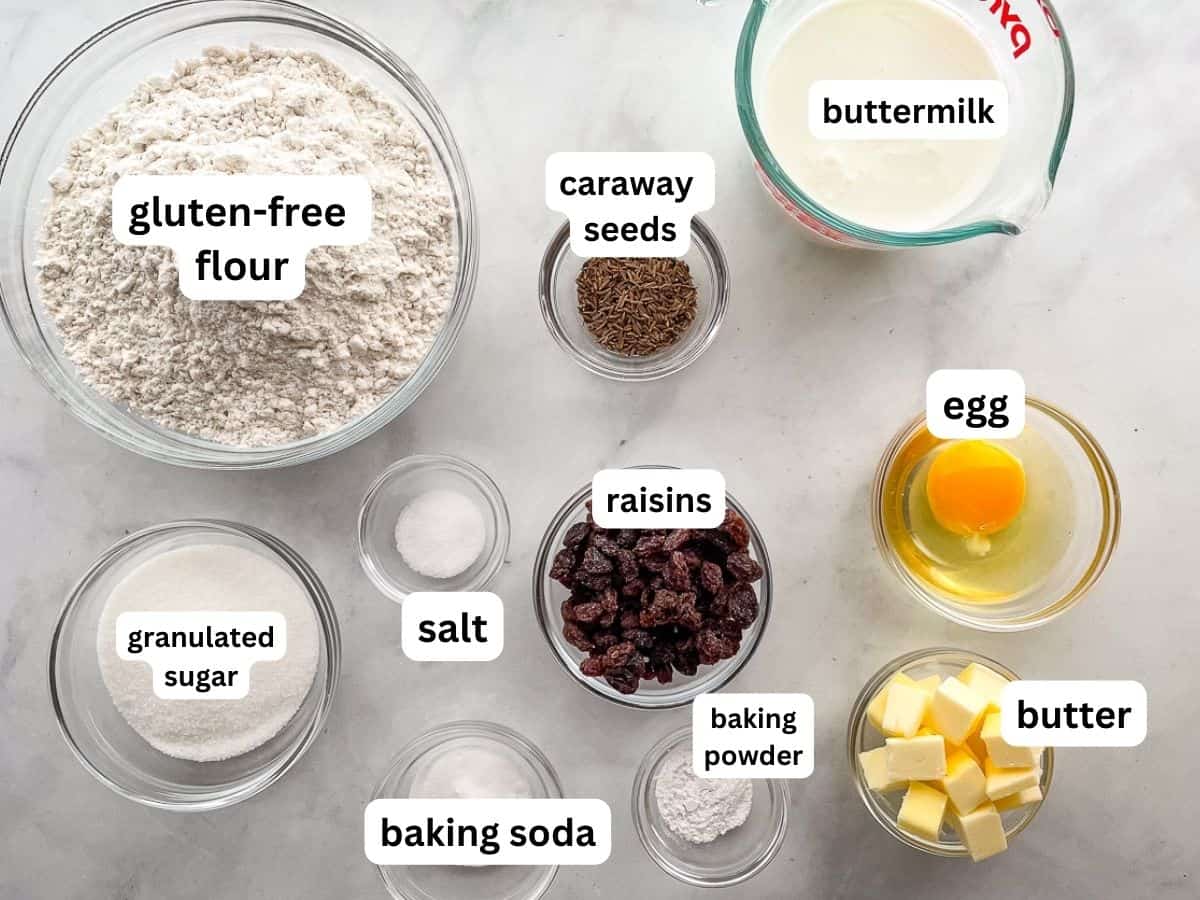
Ingredients.
Here’s what you need to make this bread. As always, the full ingredient list and steps are included at the bottom of the post.
- Gluten-Free Flour. A gluten-free flour blend works great in this easy bread. The recipe was developed with Bob’s Red Mill 1:1 Gluten-Free Baking Flour. If you use a gluten-free flour blend that does not contain xanthan gum, add ½ teaspoon xanthan gum to the recipe.
- Granulated Sugar. Brings a subtle sweetness to the bread and helps it brown.
- Baking Soda and Baking Powder. The combination of baking soda and baking powder gives this bread a nice texture.
- Salt. Enhances all the other flavors. Use table salt. It blends easily into the dough.
- Butter. Gives the soda bread flavor and richness.
- Buttermilk. Adds great tangy flavor. When combined with the baking soda, it helps the bread to rise.
- Egg. The egg helps the gluten-free dough come together.
- Raisins. (Optional) This is American-style Irish soda bread. It contains both raisins and caraway seeds. Feel free to use both or…skip both. It’s up to you.
- Caraway Seeds. (Optional)Adds an anise-like flavor and a little crunch.
Variations.
Egg-free substitutions.
To make this bread without the egg, simply leave the egg out and add two tablespoons of additional buttermilk. When made without the egg, the bread doesn’t rise quite as high but still tastes great.
Dairy-free substitutions.
If you’re dairy-free, make the following adjustments.
- Replace the cold butter with your favorite dairy-free butter or margarine.
- Buttermilk. You can use dairy-free plain yogurt or combine 1 cup dairy-free milk with 1 tablespoon lemon juice. Stir the dairy-free milk with the lemon juice to combine. Let it sit for five minutes or until it’s slightly thick.
How to Make Gluten-Free Irish Soda Bread.
Irish soda bread is an interesting bread to make. The method is similar to making gluten-free biscuits. You start by working the cold butter into the gluten-free flour. This gives the bread a wonderful texture. Here’s what you need to do.
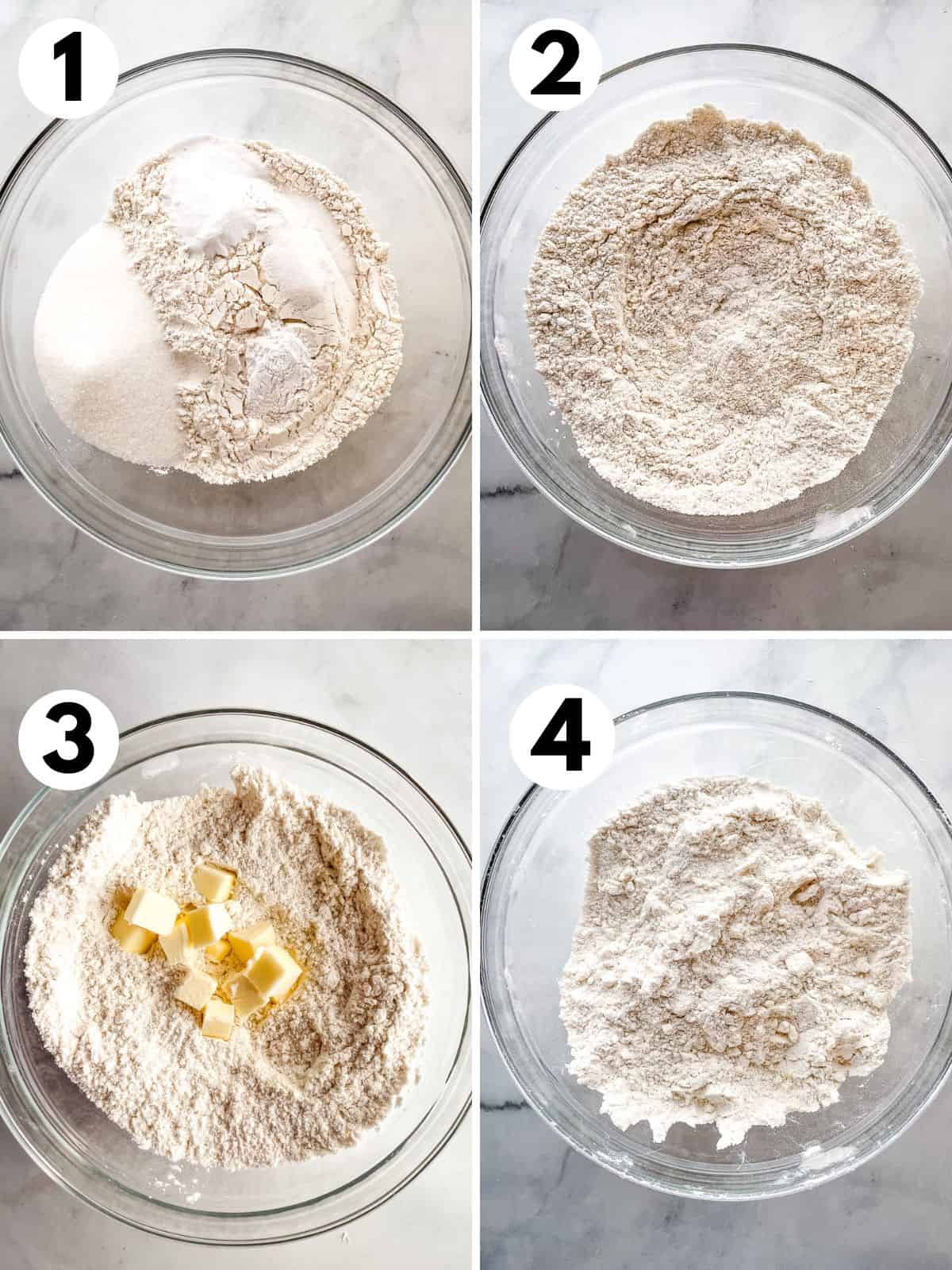
Make the Dough.
- Combine the dry ingredients. Place the gluten-free flour, sugar, baking powder, baking soda, and salt in a large bowl.
- Whisk the dry ingredients. Whisk everything together to combine. Use a whisk or large fork to do this.
- Work the butter in. Add the cold butter. I like to cut my butter into small cubes. But you can grate the butter on a box grater. Grated butter mixes easily into the dough.
- Rub the butter into the gluten-free flour. Do this with either your fingers or a pastry cutter. Work the butter into the flour until no large pieces of butter remain. If you’re using grated butter, this goes quickly.
The small pieces of butter that remain, about the size of a pea, give off steam during baking. The steam helps the dough to rise.

- Add the liquid. Once the butter is mixed throughout the dough, add the buttermilk and egg. Stir until a thick dough forms. If the dough seems dry or you notice gluten-free flour in the bottom of the bowl, add a little more buttermilk.
- Add the raisins and caraway seeds. If you aren’t using these ingredients, skip this step.
- Stir to combine. Give the dough a quick stir to incorporate the raisins and caraway seeds. Again, if the dough seems dry, add a little more buttermilk. And if it seems too wet, add a little gluten-free flour.
- Pat into a disk. Once the dough comes together, dust your counter with gluten-free flour. Knead it gently until it holds together. Then pat it into a round.

Bake Until Brown.
- Transfer the loaf to a parchment-lined baking sheet. Cut a cross into the top. Cutting the top of the dough helps it to rise. Use a sharp knife to do this.
- Bake until brown. This loaf takes about an hour to bake. Check it after 45 minutes by gently pressing on the center. It should feel firm, not doughy. A cake tester or toothpick inserted into the center should come out clean.
Baking Tip: If the top of the loaf browns before the center bakes, cover it with foil.
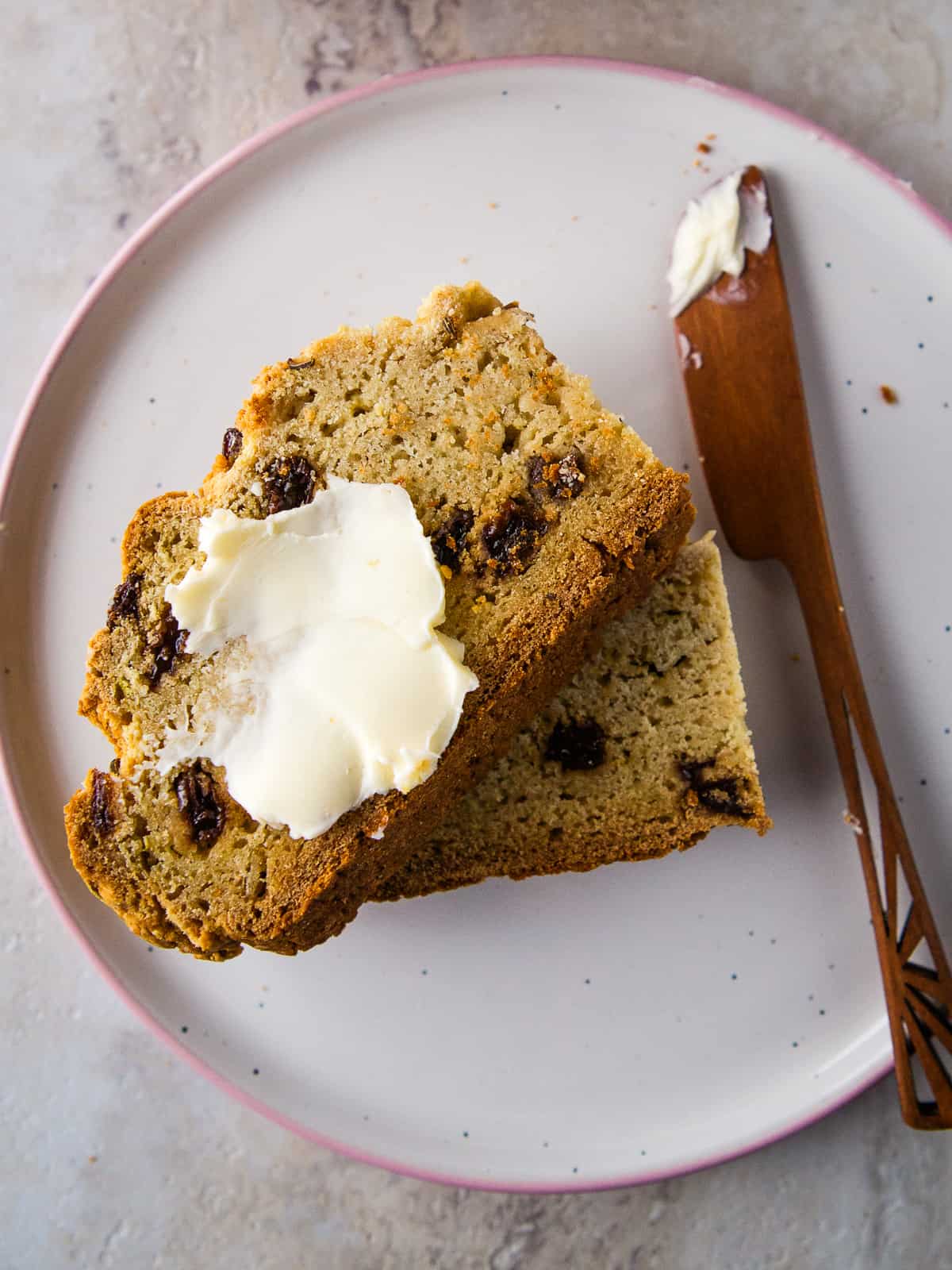
How to Serve.
I usually enjoy this bread on it’s own. Sometimes I lightly toast it and spread with a little butter. It’s also great served alongside corned beef dinner or a roast chicken and cooked green vegetables.
How to Store.
This bread lasts about three days on the counter. After that, it tends to get dry and crumbly.
Tips for Freezing.
If you want to freeze this bread, I suggest cutting it into slices before freezing. Place a piece of parchment paper between the slices to keep them from sticking. Gluten-free Irish Soda bread can be frozen in a freezer bag or container for up to three months.
Baker’s Tip: Remember to let it cool completely before freezing. If you freeze warm bread, it can trap steam, leading to poor texture or even mold. We want to avoid this! So let the bread cool and then freeze it.
Recipe originally shared March 2021. Updated to include step-by-step photos March 2024.
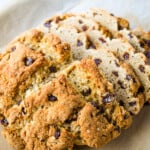
Easy Gluten-Free Irish Soda Bread
Easy Gluten-Free Irish Soda Bread Recipe. Made with gluten-free flour, buttermilk, an egg, and a little sugar. Raisins and caraway seeds optional!
Ingredients
- 3 cups Bob’s Red Mill 1:1 Gluten-Free Flour Blend, (see note) (15 ounces / 425 grams)
- ⅓ cup granulated sugar (2 ½ ounces / 70 grams)
- 2 teaspoons baking soda
- 1 teaspoons baking powder
- ½ teaspoon salt
- 4 tablespoons cold butter, cut into 4 pieces (2 ounces / 56 grams)
- ½ cup raisins
- 2 teaspoons caraway seeds
- 1 cup buttermilk, plus additional as needed (8 ounces / 226 grams)
- 1 large egg, whisked (about 2 ounces / 56 grams out of shell)
Instructions
-
Preheat oven to 375℉. Line a rimmed baking sheet with parchment paper.
-
Whisk gluten-free flour, sugar, baking soda, baking powder, and salt in a large bowl. Mix in cold butter with a pastry cutter or your fingers until no large pieces of butter remain.
-
Add buttermilk and egg. Stir until a dough forms. Stir in raisins and caraway seeds.
If the dough seems dry, add additional buttermilk, one tablespoon at a time until dough holds together.
-
Lightly dust your counter with gluten-free flour. Knead the dough a few times until it holds together. Then pat it into a round. Transfer the dough to the prepared baking sheet. Cut a cross into the top of the loaf with a sharp knife. Doing this helps the loaf to rise.
-
Bake until center is set and loaf is golden brown, about 45 minutes. If loaf gets too dark before the center is baked, cover with foil.
-
Store leftover bread on the counter. Loaf keeps for up to three days but tastes best the day it's baked.
To Freeze: Let bread cool. Cut into slices. Place a piece of parchment paper between each slice. Freeze in a freezer bag or container for up to three months.
Recipe Notes
Gluten-Free Flour
Replacing the gluten-free flour with a different flour can change the texture of the bread. If your mix does not include xanthan gum, add ½ teaspoon to the flour blend and whisk together with the flour before using.
Egg-Free Variation: To make this bread without the egg, simply leave the egg out and add two tablespoons of additional buttermilk. When made without the egg, the bread doesn’t rise quite as high but still tastes great.
Dairy-Free Variation: If you’re dairy-free, you can still make this soda bread. You’ll need to make the following adjustments.
- Replace the cold butter with your favorite dairy-free butter or margarine.
- Buttermilk. You can use dairy-free plain yogurt or combine 1 cup dairy-free milk with 1 tablespoon lemon juice. Stir the dairy-free milk with the lemon juice to combine. Let it sit for five minutes or until it’s slightly thick. If the dough seems dry, add a tablespoon or so of water or additional homemade buttermilk.
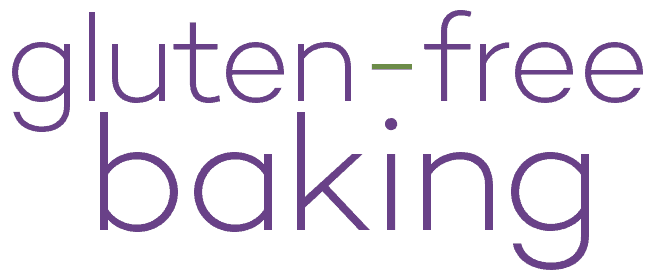


Sharon says
What can I sub for the buttermilk? I am also lactose intolerant. WOULD LACTOSE FREE YOGURT WORK..
Elizabeth says
I think yogurt would work. It’s much thicker. So you might need to add a splash of water to get the dough to the right consistency.
James says
yogurt with a bit of water also works if you just can’t find buttermilk easily
Barb McKean says
Will the recipe work without the sugar?
Ellen says
Oh, please. I apologize for not being nothing but positive, but the English language is precious to me, and it is being devastated these days.
Excuse me for correcting you, but you do not mean to
This is what you said. “If you prefer to use your own blend, replace it with the flour called for in this recipe.” That means to use what the recipe calls for rather than to use your own blend. If you want to use your blend instead of the one in the recipe, instead of Bob’s Red Mill (or whatever it is called; I am sorry I don’t remember), you might say, instead, “If you prefer to use your own blend, just substitute it for the blend called for in the recipe.”
Honestly, I cannot understand where this calling for the opposite has come from, but it is everywhere. People get the “substitute this for that” literally backwards. What you substitute for something else is what YOU USE instead of that something else, not vice versa. (And yes, I am an actual writer/editor/proofreader.)
Elizabeth says
Ellen,
“And yes, I am an actual writer/editor/proofreader.”
Then you know that pointing out mistakes, typos, and sentences that lack clarity is usually done succinctly and with professional kindness. Good editors don’t include a rant about the current state of the English language; nor do they imply the writer is an idiot. You did both.
But, hey, thanks. As someone who is also an actual writer (three cookbooks and TWO blogs!), I appreciate copyediting. The sentence has been updated.
noneya says
Seriously? You’re a “writer/editor/proofreader”? In English? Scary.
Ellen says
Sorry I cannot figure out how to edit my above comment, as it has an obvious big error in it. I assumed, which is stupid, that one could correct comments after writing them. But if that is the case, I cannot find out how to do that.
Nick says
Ellen,it cannot be fun being you.
Elizabeth says
I believe that’s called “Muphry’s law”.
Seth says
You pointed out the similarity between scones and soda bread. This got me thinking that maybe I could divide the dough into smaller, scone-sized, mini-loaves for meal-prepping. Then each meal-prepped dish of shepherds pie could have its own little soda bread biscuit. Have you tried this? What cook time would you recommend if someone were going to experiment a bit with it? I’d appreciate any suggestions and I’m happy to let you know how it goes.
Elizabeth says
I haven’t tried this but I think it would work great!
Joanna Meyerstein says
Nice recipe, thanks. You said the bread only keeps for 1 day. Is it possible to freeze?
Elizabeth says
It is! Let the bread cool and then store it in a freezer bag.
Judy Warren says
My adult son has switched to gluten free recently. I’m making this bread for the first time today (for a late St. Patrick’s Day celebration). It smells delicious. Hoping it turns out well. Very easy to make. Thank you for posting this recipe. Giving 5 stars for ease of making. With any luck, my son will give it 5 stars when he tries it.
Jody says
can’t wait to try this
MJ says
YUMMMM thank you for a simple and delicious recipe. I’m delighted with the end result! Instead of raisins and caraway seeds, I tossed in some cracked black pepper and a little rosemary since I wanted savoy verses sweet, and that worked perfectly too.
Barmarwald says
I added at least 1/4 c extra thick organic buttermilk to the mix for a nicely moist loaf of bread. Enjoyed even by family members will don’t like any gluten-free breads.
Stasi Redding says
Thank you; this recipe is great! I’ve consistently made this recipe 6 times and it comes out great. Since I’m lactose intolerant, I either use lactose free milk with lemon juice OR LF plain yogurt and some LF milk to the consistency of buttermilk. I’ve also baked this recipe into small loaves or muffins. Thanks again!
Elizabeth says
Oh yay!! I’m glad you enjoyed it!
dawn says
hi,
Can you use almond flour as a gluten free flour? Everyone seems to really like this recipe and I want to try it!
Elizabeth says
Almond flour won’t work in this recipe.
Brittany says
I tried this today and the outside was a lovely crispy, tasty brown but the inside was definitely not cooked all the way 🙁 Any suggestions?
Elizabeth says
Bummer. Next time, I’d cover it with foil and bake a little longer. This will stop the outside from getting too dark while the center bakes.
Cynthia O'Neil says
I wanted to make this for a friend for St. Patrick’s Day. Total disaster. After the first round of mixing it was still not coming together. I kept adding 1 cup of yogurt mixed with 1 tbsp of lemon juice for a total of nearly 7 cups of the yogurt/lemon juice mixture. I formed the dough into a round, placed on the baking sheet and baked for the required time. When done I cooled for 15 minutes before cutting. As soon as I cut the bread it fell apart. If you are making Irish Soda Bread I recommend using someone else’s recipe. This was a waste of time and money.
Elizabeth says
That’s very odd. May I ask why you were adding yogurt and lemon juice to the bread? Neither are called for in the recipe. A cup of buttermilk plus the egg should bring the dough together nicely. Sometimes if it’s dry out, you need a tablespoon or so of additional buttermilk. But that’s all. I can’t imagine adding 7 cups of yogurt to 3 cups of gluten-free flour.
Cindy says
I tried this. Started out halving the recipe and due to being a bit spaced out, added twice the sugar needed, made a pivot, added cocoa, cinnamon and some walnuts that had been lurking, correct amount of butter, a drizzle of olive oil and maybe three times the amount of liquid, but in the form of greek yoghurt. It had a lovely crisp crust, couldn’t believe was still delicious and edible after all my mistakes and deviations. Great recipe 😉